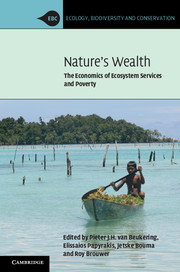Book contents
- Frontmatter
- Contents
- List of contributors
- Acknowledgements
- 1 The economics of ecosystem services and poverty
- Part I Biodiversity-related ecosystem services
- Part II Marine-related ecosystem services
- Part III Forest-related ecosystem services
- Part IV Water-related ecosystem services
- Part V Land-related ecosystem services
- Index
Part I - Biodiversity-related ecosystem services
Published online by Cambridge University Press: 05 July 2013
- Frontmatter
- Contents
- List of contributors
- Acknowledgements
- 1 The economics of ecosystem services and poverty
- Part I Biodiversity-related ecosystem services
- Part II Marine-related ecosystem services
- Part III Forest-related ecosystem services
- Part IV Water-related ecosystem services
- Part V Land-related ecosystem services
- Index
Summary
Biodiversity-related ecosystem services
Biodiversity is being depleted at an alarming rate (UN 2010). This is a problem, not only because biodiversity is intrinsically valuable, but also because biodiversity is the underlying asset from which all ecosystem services are produced. Biodiversity is best conserved in protected areas and national parks (Bruner et al. 2001). Establishing protected areas often has significant consequences for local communities. On the one hand, negative impacts occur when local communities are denied access to natural resources or are relocated to more marginal parts (Cernea and Schmidt-Soltau 2006). But even when communities are allowed to continue living near or inside protected areas the impacts of protected area establishment can be great: increased populations of wildlife increase crop damages and sometimes even cause personal injuries (Woodroffe et al. 2005) and the resource-use restrictions inside protected areas limit resource harvests for subsistence use (Wilkie et al. 2006). On the other hand, recent studies indicate that protected area establishment can also have positive livelihood effects: protected areas attract ecotourism, which can generate significant revenues at regional scale (Andam et al. 2010, Sims 2010). If these revenues trickle down to the local level, then protected area establishment can also have positive livelihood impacts at local scale.
- Type
- Chapter
- Information
- Nature's WealthThe Economics of Ecosystem Services and Poverty, pp. 31 - 36Publisher: Cambridge University PressPrint publication year: 2013



